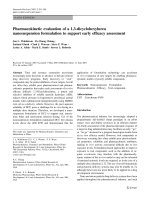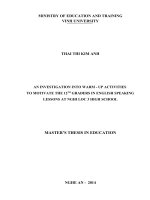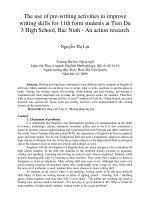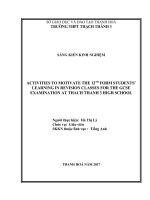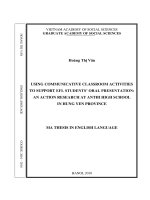Cambridge primary stage 3 worksheets activities to support y
Bạn đang xem bản rút gọn của tài liệu. Xem và tải ngay bản đầy đủ của tài liệu tại đây (4.07 MB, 52 trang )
Cambridge Primary
Stage 3
Activities to support you at home
The first word of a sentence begins with a capital letter.
This is a book.
The word I is always written with a capital I.
I am a student.
The name of a person, city, country or school begins with a capital letter.
Tanya
Mr Kim
Athens
Korea
International School
The days of the week and the names of the months begin with a capital letter.
Monday
Tuesday
January
February
Most sentences end with a full stop.
My name is Tony.
A question ends with a question mark.
What’s your name?
A sentence that shows surprise or excitement ends with an exclamation mark.
My name is Tony too!
When you write a list of things, put a comma (,) after each word. You don’t need a comma before the
word ‘and’.
I saw an elephant, a camel, a zebra and a kangaroo.
2 Cambridge Global English Stage 3 Teacher’s Resource © Cambridge University Press 2018
Use spe
eech marks to
o show some
eone is talking
g.
‘I’m tirred.’
Complette most sentences inside the speech m
marks with a full stop.
‘I need
d milk.’
Put a co
omma after a person’s wo
ords if the senntence isn’t finished.
f
‘Hurry
y up,’ shoutted the mother.
Comple
ete questions
s inside the speech
s
markks with a que
estion mark.
‘Where are you going?’
2
Cambrid
dge Global English
E
Stage
e 3 Teacher’ s Resource
© Camb
bridge Univerrsity Press 20
019
Photocopiable activity 11: Weather chart
1 Record the weather for five days
You can record the weather where you live or in another place.
Write the place.
Draw a weather symbol.
Write the day.
What’s the weather like in ___________________?
Temperature:
hot
warm
°
cool
cold
Write the temperature.
Circle the word.
2 Chart the weather
What’s the weather like? Is it sunny, cloudy, windy? Is it raining or snowing? What’s the temperature?
Record the weather for five days. You can record the weather where you live or in another place far away.
To record the weather where you live, look out the window and use an outdoor thermometer.
To record the weather in another place, look up information on a weather website.
Show your finished chart to the class and talk about the weather.
What was the highest temperature? What was the lowest temperature?
How many days did it rain?
What’s the weather like in ___________________?
Paris
Monday
Tuesday
Temperature: 30°
Temperature: 23°
hot
warm
hot
warm
cool
cold
cool
cold
144 Cambridge Global English Stage 3 Teacher’s Resource © Cambridge University Press 2016
Photocopiable activity 12: Triangle art and
Camouflage animals
Triangle art
Camouflage animals
Aim: Learners use cut-out triangles to construct a
variety of geometric shapes (Unit 4, Lesson 1, Activity
Book Challenge activity 4).
Preparation time: 5 minutes
Completion time: 15 minutes
Aim: Learners decorate a cut-out frog or butterfly
with colours and patterns that will camouflage it in a
chosen hiding spot (Unit 4, Project 1).
Preparation time: 5 minutes
Completion time: 15 minutes
Language focus: Constructing and describing
geometric shapes.
Vocabulary: Geometric shapes, comparative size.
Language focus: Identifying colours and patterns,
discussing animal location and camouflage.
Vocabulary: Colours, patterns, classroom locations,
prepositions of location, frog, butterfly, camouflage.
Materials: One copy of Photocopiable activity 12 for
each learner; scissors, crayons (optional).
Procedure
• Learners use cut-out triangles to construct a variety
of geometric shapes. Give learners a copy of the top
section of Photocopiable activity 12 (Triangle art),
scissors and crayons (optional).
• You may want to suggest that learners colour the
triangles before cutting them out.
• Have learners use the cut-out triangles to construct
shapes as they follow the instructions in Activity
Book Challenge activity 4. Encourage learners
to work with a partner to solve and discuss these
puzzles.
Materials: One copy of Photocopiable activity 12 for
each learner, scissors, coloured pencils, markers and/
or crayons.
Procedure
• Read the directions for Project 1 in the Learner’s
Book on page 60.
• Give out drawing materials, scissors and a copy
of the bottom section of Photocopiable activity 12
(Camouflage animals).
• Each learner cuts out a frog or butterfly shape and
chooses a hiding place in the classroom.
• Learners decorate the cut-out frog or butterfly with
colours and patterns that will camouflage it in its
chosen hiding spot.
• Learners who have chosen to do Project 1, place
their camouflaged frogs and butterflies in their hiding
spots. Those who have chosen to do Project 2, have
3 minutes to search and find all the camouflaged
animals.
Cambridge Global English Stage 3 Teacher’s Resource © Cambridge University Press 2016
145
Photocopiable activity 12: Triangle art / Camouflage animals
Cut out the eight triangles. Use the triangles to make different shapes.
Use two triangles. Can you make a bigger triangle? Can you make a square?
Use four triangles. Can you make a bigger triangle? A square? A rectangle?
Use eight triangles. Can you make a bigger triangle? A square? A rectangle?
Camouflage animals
Cut out the frog or butterfly shape. Where will you hide your frog or butterfly?
Colour your animal with good camouflage colours and patterns.
146 Cambridge Global English Stage 3 Teacher’s Resource © Cambridge University Press 2016
Photocopiable activity 14: Make a pinwheel
Aim: Learners use the cut-out template, a drawing
pin and a pencil with an eraser to create an everyday
invention, a toy pinwheel (Unit 5, Lesson 4, extension
activity).
Preparation time: 5 minutes
Completion time: 20 minutes
Language focus: Following directions, describing how
to make the pinwheel spin.
Vocabulary: Imperatives: cut, colour, poke, centre,
corner, top, front, back, pinwheel, drawing pin
Procedure
• Give each learner a copy of Photocopiable activity 14
(Make a pinwheel) and the necessary materials.
• As a class read and follow the instructions for making
a pinwheel.
• Learners colour, cut out and then make their
pinwheels.
• When they have finished, ask: How does the invention
work? What is making the pinwheel spin? Elicit the
answers from the class.
Materials: A copy of Photocopiable activity 14 for
each learner, drawing supplies, drawing pin, pencil
with eraser on the top.
Cambridge Global English Stage 3 Teacher’s Resource © Cambridge University Press 2016
149
Photocopiable activity 14: Make a pinwheel
What you need to make this fun invention: a drawing pin, scissors and a pencil with an eraser on the top.
Colour the front and back of
Cut out the pinwheel.
Cut on the dotted lines.
Poke holes in the centre of
Put the drawing pin through
Blow the pinwheel.
the pinwheel in each of the
each of the corner and centre
corners with the drawing pin.
holes and the top of the
the pinwheel.
eraser.
150 Cambridge Global English Stage 3 Teacher’s Resource © Cambridge University Press 2016
Photocopiable activity 16: Make your own code
Aim: Learners make up their own code and write
instructions for their partner to decipher.
Preparation time: 5 minutes
Completion time: 20–30 minutes
Language focus: Imperatives
Materials: One copy of Photocopiable activity 16 for
each learner.
Procedure
• Divide the class into three groups.
• Give each group enough copies of Photocopiable
activity 16.
• Learners work in their groups to devise a code and
write instructions for the other groups to follow.
• Remind the learners to make their instructions simple
and easy to follow.
• Learners swap their codes with another group and
work together to decode the instructions.
• Ask each group to read one instruction out to
the class. The class will then try to do all three
instructions at the same time.
• Sample instructions might be: Pat your head. Kick
your leg. Count to ten.
Cambridge Global English Stage 3 Teacher’s Resource © Cambridge University Press 2016
153
Photocopiable activity 16: Make your own code
To make your own code, write a number or letter or draw a simple picture next to each letter of the alphabet.
Write three instructions in your secret code.
1_________________________________________________________________________________________________
2_________________________________________________________________________________________________
3_________________________________________________________________________________________________
Give this code key and the instructions to your classmates to decode.
a
j
s
b
k
t
c
l
u
d
m
v
e
n
w
f
o
x
g
p
y
h
q
z
i
r
154 Cambridge Global English Stage 3 Teacher’s Resource © Cambridge University Press 2016
Photocopiable activity 17: Question cards
Aim: Learners can use this as an extension activity at
the end of Unit 8.
Preparation time: 5 minutes
Completion time: 15 minutes
Language focus: Asking and answering questions.
Materials: A copy of Photocopiable activity 17 for
each pair or group, scissors.
Procedure
• Ask learners to work in pairs or small groups. Provide
a copy of Photocopiable activity 17 to each pair of
learners or group.
• Learners cut out the cards and place them face down
in a stack.
• Then they take turns, turning over a card and reading
a question to their partner who will answer the
question.
• If this is done in a small group or as a class, each
person in the group will take turns answering the
questions.
Cambridge Global English Stage 3 Teacher’s Resource © Cambridge University Press 2016
155
Photocopiable activity 17: Question cards
✂
What would
you like to
do tomorrow?
What would you
like to buy?
What would you
like to eat
for dinner?
What would you like
to do when
you grow up?
What will you
do after
school today?
What did you
do yesterday?
Who was the
first person
you saw today?
What time do
you usually
go to bed?
What is the
date today?
(day, month
and year)
What is your
favourite food?
What is your
favourite game
or sport?
What place
would you
like to visit?
✂
156 Cambridge Global English Stage 3 Teacher’s Resource © Cambridge University Press 2016
PCM 5 Understanding instructions
Name:
Date:
Read the text and answer the questions.
How to make salt dough
You will need
What to do
2 cups of flour
1 cup of salt
1 cup of warm water
A cup for measuring
A large mixing bowl
A spoon
An airtight container
1 Mix together the flour and salt in a
large bowl.
2 Slowly stir in the warm water.
3 Mix well until the mixture feels like dough.
4 Use your hands to push the
mixture into a ball.
5 Knead for at least five minutes or
until smooth.
6 Put the salt dough in an airtight
container to keep it soft.
1 What is the purpose of this text?
2 How much water do you need?
3 Why do you need a cup?
4 How do you know the order in which you have to do things?
5 When do you stop mixing?
6 How long can you store salt dough for?
7 Tick (✓) the sentence that means the same as knead.
a Mix the dough very quickly.
b Bang the dough very hard on the table.
c Fold, press and stretch the dough over and over again.
d Put the dough in a cold place.
Cambridge Primary English Stage 3 Teacher’s Resource
© Cambridge University Press 2018
PCM 5
PCM 6 Giving instructions
Name:
Date:
Whether you are writing or speaking your instructions, you always have to think about your
readers or listeners. How can you help them to read/listen successfully?
Read this list of ideas. Add any more of your own.
In writing
In speech
Begin with a ‘How to’ or ‘We are going to’
statement.
Begin with a ‘How to’ or ‘We are going to’
statement.
Include a list of things you need.
Include a list of things you need.
Use command verbs.
Use command verbs.
Make sure that sentences begin with command
verbs or sequencing words.
Make sure that sentences begin with command
verbs or sequencing words.
Give clear, step-by-step instructions to allow
readers to read successfully.
Give clear, step-by-step instructions to allow
listeners to listen successfully.
Only use important adjectives.
Only use important adjectives.
Start a new line for each instruction.
Only give one or two instructions at a time.
Use diagrams and pictures to help readers
see what they have to do.
Show listeners what to do before they do it.
Speak clearly and allow listeners time to do
what you say.
Give clear answers to listeners’ questions.
Use these lists to check that you or a talk partner are giving good instructions.
Cambridge Primary English Stage 3 Teacher’s Resource
© Cambridge University Press 2018
PCM 6
PCM 8 Instructions writing frame
Name:
Date:
How to
Equipment
1 First
2
3 Next
4
5
Useful words
first
behind
then
between
after that
beside
next
in front of
finally
inside
outside
pull
push
put
stack
throw
kick
Cambridge Primary English Stage 3 Teacher’s Resource
© Cambridge University Press 2018
PCM 8
PCM 11 Understanding fables
Name:
Date:
Read the fable and answer the questions.
The Three Fish
Three fish had lived together in a pond for many years. The oldest fish worried about
so many things that it sometimes irritated the youngest fish.
One evening the fish overheard some men discussing their pond. “Look,” said one.
“This pond is full of fish. Why have we never fished here before?” The men agreed to
return the next day with their fishing nets.
No sooner had the men gone than the oldest fish turned to the others and said, “Did
you hear that? Tomorrow those men will come and kill us all. We must leave our pond
and find a new home.”
The youngest fish laughed and said, “What? Leave this beautiful pond? I say we stay.
We were lucky to find this pond so many years ago. We will be lucky again
tomorrow.”
That evening the youngest fish watched his oldest friend set off down the stream with
his family. “What are you going to do?” he asked his remaining friend.
“I don’t know,” the second fish replied. “I’ll decide in the morning.”
The next morning the second fish saw the fishermen in the distance “I’m going,” he
said. “The oldest fish was right.” Quickly, the second fish gathered up his family and
left the pond.
“Don’t worry about me,” said the youngest fish. “You’ll see. I’ll be lucky.”
The fishermen spent all day at the pond. They caught all the fish – even the fish who
thought his luck would keep him safe. That evening, as the fishermen had a feast, the
oldest fish and the second fish returned to the pond with their families.
Adapted by Kate Ruttle from the Panchatantra, a collection of ancient Indian fables.
1 Do you think this is a true story? Explain your answer.
2 Why did the youngest fish think they should stay?
3 How did the oldest fish leave the pond?
4 What made the second fish leave the pond?
5 What is the moral of the fable? Tick (✓) the best answer.
a
b
c
d
It is sensible to worry all the time.
When you know trouble is coming, do something about it.
Fish that have families survive better than those that don’t.
Fishermen are cruel to catch fish.
Cambridge Primary English Stage 3 Teacher’s Resource
© Cambridge University Press 2018
PCM 11
PCM 12 Punctuating dialogue
Name:
Date:
1 Can you punctuate this dialogue? Add speech
marks (“ ”) round the words people say.
2 The word said is used too often. Replace at
least five examples of the word said with
another word. There are some suggestions at
the bottom of the page.
The old man led his visitors to a chair.
“Please sit down,”
he said.
Thank you, sir, they said.
Would you like a drink? he
said.
No thank you, they said. We wanted to ask you if you knew any stories.
What kind of stories? he said.
Stories about where we live, they said. We were told to talk to people who might know
the old stories.
You want to hear the old stories? said the old man. It’s a long time since anyone asked
me to tell my stories. If you want to hear a story, you will need something to drink, and
so will I. Some of my stories are quite long.
So the old man made everyone a drink.
Well, he said. Where shall we start?
asked
answered
invited
cried
repeated
Cambridge
Primary English Stage 3 Teacher’s Resource
© Cambridge University Press 2018
declared
replied
demanded
told
PCM 12
Cambridge Primary English Stage 3 Teacher’s Resource
© Cambridge University Press 2018
PCM 13
Main event 2:
Introduce the setting.
Main event 1: The first character
wants something but can’t get it.
Main event 2: The first character
persuades the second character
to get what he wants.
Main event 3: The second
character does it but gets hurt.
They are roasting chestnuts by
the fire.
The monkey wants a chestnut.
He burns his paw.The monkey
flatters the cat.
The cat gets the chestnuts but
burns her paws.
The monkey eats the chestnuts.
Main event 3:
Main event 1:
Introduce the two main
characters. All is well.
The cat and the monkey are
good friends.
New fable
Pattern
Original
Get ideas for your fable by looking carefully at a fable you already know, like The Monkey and the Cat. Think about the pattern
of events and change something to make a new fable.
Name: ________________________________________________________________ Date: _________________________________________
PCM 13 Boxing up a fable
PCM 15 Plan for a recount of an experience
Name:
Date:
Remember to say what happened, who was there, when it happened, where it
happened and why or how it happened.
First
Past tense verbs
did
had
liked
made
saw
was
walked
went
After that
Time words
as
at last
before
early on
first
later on
meanwhile
next
Then
I felt
angry
bored
eager
encouraged
excited
happy
scared
silly
successful
Finally
Cambridge Primary English Stage 3 Teacher’s Resource
© Cambridge University Press 2018
It looked
amazing
difficult
delicious
fragile
interesting
important
Outstanding
scary
powerful
PCM 15
PCM 17 Understanding letters
Name:
Date:
Read the letters and answer the questions.
1 Dear Frida,
Congratulations! You are an aunt!
Our little baby, Bruno, was born last night. We enclose lots of photos of him for you to enjoy.
I know that you hoped for a niece, but I’m sure that you’ll come to love your nephew as
soon as you meet him. He looks just like you when you were born, and I think he’s going to
have the same colour hair as you.
Come and meet him at the weekend.
Your loving bother,
João
2 Sunday 27th
Hi Samir,
This is just a quick note to say well done for playing so well on Friday. Without you, we
would have lost the match. You played well yourself, but you were also very encouraging
to your teammates so they played better too.
I hope you’ll stay on the team for a long time.
See you at the practice on Wednesday.
Coach
1 What is the name of João’s sister?
2 Why did João write to his sister?
3 Is Bruno the sister’s niece or nephew?
4 Who wrote to Samir?
5 Give two reasons why Samir helped to win the match.
6 When does Samir’s team meet each week?
Cambridge Primary English Stage 3 Teacher’s Resource
© Cambridge University Press 2018
PCM 17
PCM 21 A character portrait of Alfie
Name:
Date:
Alfie Small is lost! Please help find him.
This is a picture of Alfie.
Information about Alfie
Age:
Height:
Eye colour:
This is a description of the kind of person Alfie is.
Cambridge Primary English Stage 3 Teacher’s Resource
© Cambridge University Press 2018
PCM 21
PCM 23 Understanding adventure stories
Name:
Date:
Read the story and answer the questions.
“But what happened to the dragon who’d been spiked by the spear?” asked Lily
Granda shrugged. “Poor beast would be all heart-a-thumping for a time, I dare
say. She’d lick her wound. In time she’d go back to sleep, but she wouldn’t sleep
easy. Frights like that live long after the reason for them is done with.
“One hot, humid summer’s night, the people of the village were asleep. The dragons
slept too, a slump of slumbering hills that rumbled every now and again with
thundering snores.
“The Dragon Hills were still as stone – a gentle breeze coming from their sleeping
breaths. A tiny puff of thistledown came floating on that breeze. It breathed up and
down above the great beasts until, all of a sudden, it breathed right up into the nose
of a dragon – the last one to have been spiked by the Fire Snatcher.
“She was only a young dragon, and she’d been made all jumpy-frit by the scare of
it all. The thistledown tickled her nose and made her wake with a sneezy snort.
“A tiny spark from her fiery breath drifted onto the breeze and floated over to the village
where it fell down into a pile of hay and burst into flames. Fire spread quick-fast.”
From Dragon Boy by Pippa Goodheart
1 Why would some dragons not sleep very well?
2 What sounds came from the hills?
3 Which dragon woke up?
4 Why did the dragon wake up?
5 What did she do when she woke up?
6 Fill in the gaps in this short version of the story.
1 The dragons were asleep.
2
3 She snorted a spark.
4
5
6 The fire spread quickly.
Cambridge Primary English Stage 3 Teacher’s Resource
© Cambridge University Press 2018
PCM 23
PCM 24 Book review writing frame
Name:
Date:
Title
Written by
Tips
My review
Think of an
adjective to
describe the book
and explain why.
I think this book is
Illustrated by
because
The book is
What type of book
is it?
Think of an
adjective to
describe the plot.
I think the plot is
Write a short
account of what
happens in the
book.
The most interesting bit is when
Who is the main
character?
The main character is called
Write some
sentences to
describe the main
character and draw
a picture of him/her
doing something in
the story.
He/She is
Write one or two
sentences to tell
people why they
should read the
book.
I think you should read this book because
Cambridge Primary English Stage 3 Teacher’s Resource
© Cambridge University Press 2018
PCM 24
PCM 26 Understanding information texts
Name: _________________________________________
Date: ___________________________
Read the text and answer the questions.
Australia
Australia is a huge island between the Indian and Pacific oceans. All of the countries
nearby, such as New Zealand and Indonesia, are islands too but none of them are as big as
Australia. It is the world’s sixth largest country.
Australian cities
Most people in Australia live in cities. Almost all of the cities in Australia are near the coast
because that’s where the weather is best. It’s also where the beaches are.
There are over 7000 beaches in Australia!
The Outback
The centre of Australia is a huge desert called the Outback. It is very dry and flat with red
earth. In the middle of the Outback there is a town called Alice Springs. Many tourists visit
Alice Springs because they want to see the mountain-sized rock nearby. It has two official
names: Uluru and Ayers Rock. Uluru is the traditional Aboriginal name for it. Ayers Rock is
the English name given to it in the 19th century.
Aboriginal Australians
Aboriginal Australians have lived near Uluru for thousands of years. Many Aboriginal
Australians still live in the Outback and some live in the cities. Aboriginal culture is very
rich and includes myths as well as its own style of painting and music.
1 Which two oceans surround Australia?
_______________________________________________________________________________
2 Tick (✓ ) the true statement.
a Australia is the sixth largest country in the Pacific Ocean.
b Australia is the sixth largest island in the Pacific Ocean.
c Australia is the sixth largest island in the world.
d Australia is the sixth largest country in the world.
3 Give two reasons why most Australian cities are near the coast.
_______________________________________________________________________________
4 What colour is the earth in Alice Springs?
_______________________________________________________________________________
5 Why do so many people go to Alice Springs?
_______________________________________________________________________________
Cambridge Primary English Stage 3 Teacher’s Resource
© Cambridge University Press 2018
PCM 26
PCM 29 Understanding funny poems
Name:
Date:
Read the poem and answer the questions.
The Jumblies
1 They went to sea in a Sieve, they
did, In a Sieve they went to sea:
In spite of all their friends could
say, On a winter’s morn, on a
stormy day, In a Sieve they went
to sea!
And when the Sieve turned
round and round,
And everyone cried, ‘You’ll all be
drowned!’
They cried aloud, ‘Our Sieve ain’t
big, But we don’t care a button,
we don’t care a fig!
In a Sieve we’ll go to sea!’
Far and few, far and few,
Are the lands where the Jumblies
live;
Their heads are green, and their
hands
are blue,
And they went to sea in a Sieve.
2 The water it soon came in, it
did,
The water it soon came in;
So to keep them dry, they
wrapped their feet
In a pinky paper all folded neat,
And they fastened it down with a pin.
And they passed the night in a
crockery-jar,
And each of them said, ‘How wise we
are!
Though the sky be dark, and the
voyage
be long,
Yet we never can think we were rash
or wrong,
While round in our Sieve we spin!’
Far and few, far and few,
Are the lands where the Jumblies live;
Their heads are green, and their hands
are blue,
And they went to sea in a Sieve.
Edward Lear
1 What did the Jumblies use instead of a boat?
2 What was the weather like when they started?
3 Did their friends think it was a sensible decision?
4 Do you think it was a sensible decision? Explain your answer using ideas from stanza 2.
5 How do we know that they didn’t mind?
6 How do the Jumblies look different from you?
Cambridge Primary English Stage 3 Teacher’s Resource
© Cambridge University Press 2018
PCM 29

